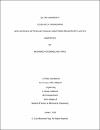NEW APPROACH OF PIPELINES JOINING USING FIBER REINFORCED PLASTICS COMPOSITES
| Advisor | Saad, Elsadig Mahdi |
| Author | FARAG, MOHAMED HOSSAMELDIN |
| Available date | 2019-02-28T07:57:09Z |
| Publication Date | 2018-01 |
| Abstract | It is well known that maintenance of pipelines failures due to leakage or rupture caused by either corrosion or lack of strength is a significant challenge for pipelines engineers. Pipelines joining is considered as a significant challenge since many of pipelines failure cases have been observed to be related to joining. The classic methods of joining pipelines including welding have many limitations that result in properties weakening, accelerate corrosion, and hence lead to failure and unexpected shutdowns in oil and gas field. This study aims to introduce a different solution for pipes joining using fiber-reinforced plastics (FRP) composites. An investigation of the effect of different types of FRP on the mechanical behavior of joints regarding bending behavior and internal pressure capacity compared to welding has been carried out through six phases. In phase 1, a fabrication processes in which aluminum pipes have been prepared to be used later for wrapping with different FRP and welding. The FRP used are Kevlar fiber/epoxy (KFRP), carbon fiber/epoxy (CFRP), and glass fibers/epoxy (GFRP). These fiberes have been cut into strips and utilized in the joining systems using fabric winding method. On the other hand, two types of welding have been used to study their effect on pipe’s mechanical behavior. These are V-welding technique and normal faced butt-welding technique. Optimization of fiber orientation of joining system under three-point bending test, where CFRP has been used with 00/900 and ±450 orientations has been discussed and presented in phase 2. The results showed that 00/900 orientation has the highest flexural load. In phase 3, evaluation of fiber type effect on bending behavior of joined pipes has been carried out for different FRP composites types with four layers and compared to welding. Accordingly, the non-joined aluminum pipe has been investigated under three-point bending test as a control for the study. In addition, the V-welded pipes, as well as normal faced butt-welded pipes, have been investigated under three-point bending test. The results for V-welded pipes showed higher mechanical performance than normal faced butt-welded pipes. To this extent, KFRP showed the highest flexural load, and CFRP showed higher value of flexural load than welding techniques, while the GFRP showed similar flexural load to welding techniques. In addition, phase 4 involved assessment of FRP hybridization on bending behavior of joined pipes, where GFRP/CFRP and KFRP/CFRP of four layers and eight layers have been assessed. The results showed that four layers the of FRP hybridization are insignificant compared to four layers of single FRP type, while eight layers resulted in improvement in flexural loads compared to four layers of single FRP type. Based on the bending results, phase 5 has been dedicated to evaluate the internal pressure capacity of the optimized pipes, in which two types of pipes have considered. These are pipes joined with four layers of KFRP and eight layers of KFRP/CFRP. The results showed improvement in the pipe’s internal pressure capacity compared to welding. Finally, corrosion test has been carried out in Phase 6. The results showed that FRP joining systems have higher corrosion resistance compared to welded and non-joined pipes. These results revealed that using FRP composites in pipes joining showing a promising future for pipes joining. |
| Language | en |
| Subject | fiber-reinforced plastics (FRP) maintenance of pipelines |
| Type | Master Thesis |
| Department | Mechanical Engineering |
Files in this item
This item appears in the following Collection(s)
-
Mechanical Engineering [67 items ]


